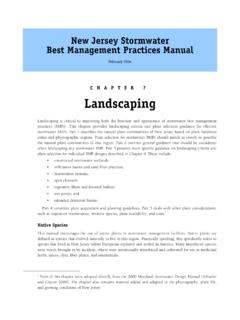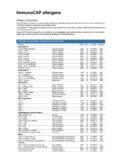Transcription of A Summary for Consultants, Engineers and Architects
1 NIRBC Constructed Wetlands for Northern Ireland The Northern Ireland Reed Bed Company . A Guide to Specifying Reed Beds and Constructed Wetland Systems A Summary for Consultants, Engineers and Architects Introduction Reed Bed Treatment Systems (RBTS) have been in use throughout Europe and North America for many years and have evolved as mainstream techniques in the treatment matrix for many companies and organisations. There are many processes at work within RBTS. Effective design is based on creating the right balance of processes for the required treatment. The various concepts of sustainability, biodiversity, SUDs and environmental good practice can all be incorporated within simple, robust structures which are also visually appealing. RBTS are frequently specified in environmentally sensitive areas and where obtaining planning permission is problematic. There is now sufficient knowledge and data on RBTS to achieve consistent predictions of treatment standards for most applications.
2 Case studies are available from reliable sources which have promoted confidence in the various techniques. What is a Reed Bed? A reed bed is an engineered structure, usually a shallow excavation not more than one meter in depth, into which is laid an impermeable liner. Media, usually clean washed 10mm gravel, is placed within the bed to provide filtering and surface area for bacteria (biofilm) to develop. Water is introduced in the bed via a pipe or dosing system where it stays for a period of time. Various processes take place within the bed, including sedimentation, microbial degradation, and chemical breakdown. The reeds help the process in two main ways. i. The stem transfers oxygen to the active layer around the root structure, which keeps the area aerobic. ii. The roots maintain the spaces between the gravel pieces to maintain a pathway (hydraulic conductivity) for the water. Simple techniques are employed to retain water and control level and flow.
3 Usually, RBTS are designed in sequential stages to treat water to the required standard. Planning and Consent to Discharge (NI Only) Planning Service does not require an application for construction of reed beds as replacement systems for existing treatment for single domestic dwellings only. The entire system should be within the curtilage of the property and may be specified, for example, to replace a failed soakaway. Other reed bed systems may require a planning application. 2 All reed bed applications which discharge water to the environment require a Consent to Discharge certificate from EHS (Water Management Unit). The application process currently takes from three to six months. There are two types of application depending on the type and volume of discharge (Form WO1/WO2). Advice should be sought from EHS (WMU) if required. Types of Reed Bed Construction There are three main types of reed bed construction: i.
4 Surface Horizontal Flow (SHF). This design allows water to flow over the surface of the bed between the stems of the reed plants which are planted in earth. The water is visible, usually to a depth of around 150mm. This design is effective for settling out solids prior to further treatment, or to balance flows into further reed bed stages. SHF reed beds are not generally appropriate for BOD removal because it has limited aerobic capability and little surface contact area for biofilm to develop. ii. Subsurface Horizontal Flow (SSHF). This design allows water to flow below the surface of the reed bed through gravel media. The reed plants are planted in the gravel. There is no visible water in the bed and as such presents no public safety or odour problems. The reed plants are allowed to die back in winter and form a warm composted layer which protects the biofilm below. This design is effective in reducing SS, BOD, COD, and partial ammonia removal.
5 It is also effective in removal of pathogens, hydrocarbons, some heavy metals and nitrates. iii. Down Flow or Vertical Flow (VF). This design requires dosing of the surface of the bed using a network of pipes and either a pumping or a siphon system. The idea is to flood the surface of the reed bed a number of times per day. As the water flows down through the bed it draws air in, creating a highly aerobic environment. VF reed beds are very effective in removal of BOD, ammonia and some heavy metals, and have a smaller footprint for similar treatment compared to SSHF . VF reed beds must be very carefully designed in order to work effectively for extended periods. Of particular importance is the grade and quality of the media in the bed. The efficiency of SSHF and VF reed beds may be improved by adding certain chemicals to the water during the treatment. For example, this technique can be used for COD or phosphorous removal in industrial process water.
6 Some or all of the above basic designs can be incorporated within a treatment system in order to progressively treat water. 3 System Components i. Inlet distribution pipework. The design requirement is to introduce water to the bed in an even and steady flow. Water flowing too fast into the bed will scour the biofilm from the media. Uneven flow across the inlet end in SHF and SSHF will result in short circuiting of the bed. This is where water forms streams within the body of the bed. This affects the quality of treatment by limiting the amount of contact between the water and the biofilm. Poor design will result in blockage at the inlet. ii. Process Area. This is the main body of the bed where treatment takes place and describes the active area of the reed bed for design purposes. The edges of the process area are angled at approximately 45 degrees and lined with stones to prevent small animals from becoming trapped in the reed bed.
7 The collection gallery is enclosed within the process area. iii. Collection Gallery. The gallery comprises perforated pipes which intercept treated water and carry it to the level controller. iv. Level Controller. The level control unit maintains the water level within the reed bed, thereby controlling the residence time, and hence treatment, of water within the system. Control is achieved by means of an adjustable spiller pipe within a chamber and then to the environment. Water flows from the reed bed through the spiller pipe and into the chamber. The spiller pipe level is maintained by means of a tethered chain. Sometimes more elaborate level control methods are specified, however this simple design is usually satisfactory. Electrical Power Requirement It is usually desirable to avoid the requirement for power to a reed bed site. Provided there is sufficient fall, it should not be necessary to install power for SF and SSF reed beds.
8 The simple design usually negates the requirement for control or monitoring systems in small works. In the case VF reed beds, dosing can sometimes be achieved using a siphon pump, otherwise a suitable electrical pumping system is required. Plants Many types of macrophyte may be used in reed bed construction, but the common reed (Phragmites australis) and the reed mace (Typha latifolia) are most widely used. Of these the common reed is usually favoured because of its very vigorous growth and hardiness. The plants usually grow to maturity within two years when they will be almost two meters high. The roots extend approximately 500mm downwards from the surface of the bed, which determines the optimum depth of gravel media in SSHF reed beds. 4 Applications for RBTS (See Application Summary ) Type Removal Horizontal Flow Surface SS Metals Sub-surface BOD(Low) Secondary/Tertiary SS Down Flow/Vertical Flow BOD(High) Whole Sewage Ammonia Sludge Hybrid BOD SS Ammonia Longevity Research by WRc and Severn Trent Water suggests that RBTS which are designed and maintained properly should perform within their specification for around 15 years.
9 Severn Trent Water, which operates over 300 reed beds, is currently beginning a refurbishment programme for reed beds which have been in use for between 12 and 15 years. Maintenance and Refurbishment One of the major benefits of RBTS is the low maintenance regime required to maintain a good standard of operation. Routine maintenance can usually be carried out by semi-skilled workers, and amounts to weeding the bed and observing water flowing from the level control system at the outflow of the bed. This makes RBTS very cheap to operate throughout the life of the system. The most crucial period for a reed bed is the two years following installation. It is very important that there is good and consistent flow through the bed and that reed growth is vigorous and even. Weed invasion should be minimised during this period to ensure that the reed plants get the very best opportunity to establish. Without this care in the early years RBTS are unlikely to achieve the design treatment standard.
10 For this reason, reputable reed bed companies maintain close contact with clients for at least two years following installation. Over the lifetime of a reed bed solids will accumulate, particularly at the inlet end of the system. Sometimes this may result in blocking of spaces and some surface flow, but this will not largely affect the treatment quality as long as it is limited to a small percentage of the total process area. 5 Quality Quality assurance regarding treatment is determined from past experience and analysis of reed bed treatment using data derived from various sources. R and D work in the UK has been undertaken by WRc, Constructed Wetlands Association (CWA), Severn Trent Water, and ARM Ltd. There is also data available from overseas sources such as EPA (USA) and other government agencies. There is, as a result, growing confidence in the effectiveness of RBTS. Where there is no direct comparison for some applications, reasonable assumptions are made and sampling regimes set up to monitor effluent.





